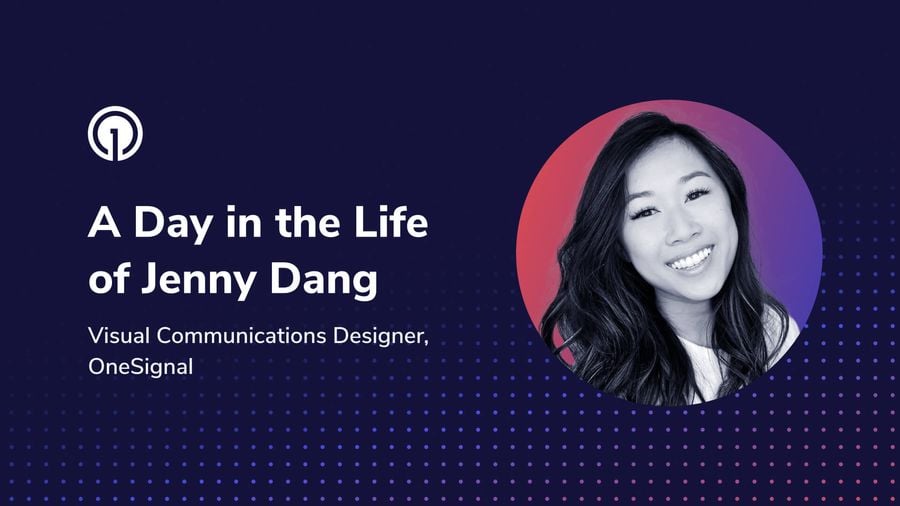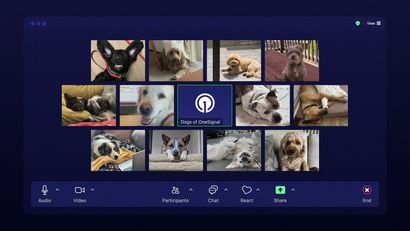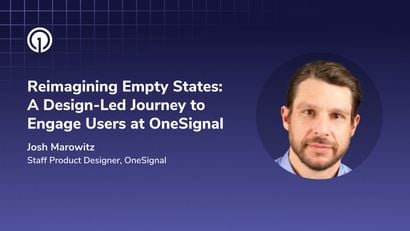Welcome to our inaugural A Day in the Life blog post, where I get to sit down with visual communications designer, Jenny Dang. You can see Jenny's work at OneSignal in a variety of contexts — whether you're admiring the release posters on the wall at HQ, sporting our latest company swag, or talking about our engaging eBooks, her design impact has been profound. I sat down with Jenny to get the full scoop on everything she does here, what inspires her, and what advice she’d give to someone looking at a similar career path.
Samantha Perlman: At OneSignal we have multiple types of designers. I know you’re a Visual Communications Designer. For myself and our readers who are maybe less versed in the nuances of different design roles, can you explain for us the difference between a Visual Communications Designer and a Product Designer?
Jenny Dang: Visual Communications Designers at OneSignal are responsible for defining, evolving, and maintaining the company's brand and marketing/sales materials. They collaborate with various teams to ensure brand consistency and appeal, working on projects such as the website, blog, ebooks, and presentations.
On the other hand, a Product Designer's role is centered around improving the user experience and functionality of OneSignal's product. They collaborate with cross-functional teams to define product requirements, conduct user research, and design intuitive interfaces and are heavily involved in designing new product features.
SP: Can you walk us through a typical day in your role as a visual communications designer at OneSignal?
JD: A typical day for me starts with checking my calendar for any scheduled meetings. I also like to have my Asana app open at all times to see my upcoming projects clearly.
Mondays really help kick off my week with a series of crucial meetings. In the morning, we begin with Design Planning, where each designer shares their weekly priorities and discusses ongoing/upcoming tasks, providing valuable visibility into the work of Product Design, Design Engineering, and Visual Communications Design. Later, we engage in a Product/Design sync meeting, going over things like customer & business insights, product roadmap progress, and demoing any new design features or projects. In the afternoon, Lee (Head of Design), Catherine (our Senior Visual Communications Designer) and I meet with the Marketing team to align on priorities and address any additional design requests, setting a clear structure for the week ahead.
When it comes to my projects, I like to divide them into larger, more time-intensive tasks that require a bit more research and planning (e.g. event signage, ebooks, website redesigns) and smaller, quicker tasks that follow a standardized process (e.g. blog headers, email and social assets). I prefer tackling the “smaller” tasks first to address them quickly. I find it efficient to templatize things and create components in Figma, which makes it easier to handle similar future design needs from Marketing. This has been especially helpful with our blog and email assets. For larger projects, I collaborate closely with our Marketing team. They provide a clear expectation and outline for project goals, and I can then ideate and execute from there. Overall, I do spend most of my day working independently, with occasional team collaborations to ensure we're all aligned in the direction of the project goals.
SP: How do you collaborate with other teams, such as marketing or product development, in your design process?
JD: Usually, there's an initial kickoff meeting scheduled early in the quarter, where we go over project expectations and timelines and address any potential blockers. From there, we share weekly updates on progress. It’s very easy to collaborate with the Marketing team — they’re very responsive and bring their own creative ideas to the table.
During the design phase, I like to create mockups to visualize ideas and offer variations of the designs to discuss further. I then share these with the relevant teams for feedback and iteration if necessary. This feedback loop ensures that everyone's input is considered, leading to a more refined and effective design. After finalizing, I work closely with team members involved to ensure that the implementation aligns with the overall goal. Effective communication and collaboration via weekly meetings and Slack are crucial for keeping everyone informed and aligned during this process. I value the strong sense of teamwork that comes into play, particularly when working with the marketing team.
SP: We always have fun swag, both for our employees and for events. How do you come up with the design for these?
JD: With the Yeti Cooler, our overall event theme tied along with the headline: It’s all about the (customer) journey. Ultimately, I took inspiration from our Journeys icon and then created concepts for a backdrop design which I then applied to our Yeti Coolers. My background is very illustration-based and I’m fortunate that Lee (Head of Design) encourages me to access my illustrative side whenever it’s fitting, so it’s great that I get to implement that in certain projects such as these large, in-person events. And then, of course, I incorporate our branding colors and ensure it stays consistent with our brand’s look and feel.

For internal swag, there’s usually an initial call with Lee, our Head of Design, and we loop in Long, Co-founder & COO, to confirm what direction we’re aiming for. We typically aim to be creative and fun, often bringing in pop culture references if we can. For our recent winter offsite swag and posters, the initial direction was to create designs with a winter theme. For an open-ended request like this, I like to brain dump some ideas onto paper, take words, phrases, and pop culture inspiration, and visualize what the imagery surfaces in my imagination from there. I like to design at least four or five different concepts that offer a variety of styles to choose from. I also enjoy creating mockups of the designs on t-shirts to give stakeholders a better idea of how they will look in real life. Ultimately, the team and I voted on the “Winter is Coming” design, drawing inspiration from the “Game of Thrones” franchise.
SP: What tools or software do you rely on to bring your designs to life?
JD: There are many tools that I rely on to bring my designs to life. However, our design team largely uses Figma. Figma is where all of our designs exist, from product design to visual design projects. We also develop many of our Design Systems within Figma, making it a valuable tool for the design team. Coming into Onesignal, I had pretty limited experience with Figma but I had prior knowledge of similar tools, so working with Figma felt intuitive to me. Other tools I use consistently are Adobe Illustrator, Photoshop, InDesign, and AfterEffects. When it comes to more illustrative artwork such as poster designs and internal swag, I enjoy using my iPad Pro to sketch some ideas in the Procreate app. I also find it very efficient to utilize during the brainstorming phase.
With the rise of AI tools, Lee has also encouraged the team to explore their potential for enhancing our design process. So lately, I have been utilizing tools such as ChatGPT to help with generating placeholder content for designs or messaging examples or to even get initial high-level inspiration for a design project. It’s great to be a part of a design team that actively seeks out and shares new tools and resources, especially if they can help improve our workflow.
SP: At OneSignal, we have a unique tradition in creating posters for each of our big product launches and I know you’ve been involved in a number of them. Do you know how this tradition started? And what factors do you consider when creating these posters?
JD: The poster tradition was underway before I started - in the past, we hired a contractor to create posters for specific OneSignal milestones and achievements, such as Journeys and User Model. Given my background and passion for drawing and illustration, Lee presented me with the opportunity to design the posters myself, eliminating the need for a contractor. I was thrilled to accept the challenge! Working on these designs gives me complete creative freedom, as seen with poster designs like the Design Principles, Beam Documentation and Winter Offsite posters. I appreciate any chance I get to fully unlock my creativity and bring a bit of my style to the poster designs.

SP: How do you stay up to date on design trends and techniques?
JD: I definitely make a point to stay on top of new developments like ChatGPT and Midjourney, which we already touched on. Additionally, during the early design phases, I like to spend a good amount of time gathering research and inspiration; taking notes of what works and doesn’t.
Honestly, Google is a great resource when it comes to gathering resources and learning new skills. It’s been particularly handy with things like learning html/css to support our latest Email Design System implementation and YouTube has also been helpful for me when it comes to AfterEffects motion graphics tutorials. I also like to reach out to more experienced team members for any advice and creative direction.
Additionally, following a lot of design accounts, hashtags etc on socials has been great at giving me inspiration and overall, getting an idea of what trends others designers are implementing. Even if it’s not something I can necessarily apply into the work I do at OneSignal, it's inspiring to see the new styles and techniques that other designers are incorporating into their work.
SP: Can you tell us about a project you're particularly proud of?
JD: I take pride in all the projects I contribute to, but one that stands out right now is the designs for larger in-person events like MAU Vegas, which is something I’m currently working on. This project has provided me with valuable experience in creating larger-scale designs compared to the smaller screen designs I usually work with. I collaborate closely with our Event Marketing Manager, Taylor, who plays a significant role in planning, organizing, and promoting our company events. It's rewarding to collaborate with skilled individuals to create the final product and contribute to the overall experience. Being able to see my work out in the world is particularly rewarding in things like event backdrops, signage and swag.

SP: What inspired you to pursue a career in design?
JD: Like many designers, it started with my passion for art — specifically exploring traditional art forms, which ultimately led me to pursue a career in design. Growing up, I would watch my uncle create large oil paintings in the living room, which is where my love for it began. Although I wasn't allowed to touch my uncle’s oil paints, I started drawing and painting on my own, exploring mediums like acrylics, pens, pastels, etc. I really enjoy the act of creating. There’s just something so special about having ideas in my imagination come to life with my own two hands. When I got older, I knew I wanted to pursue my passion but took the more digital approach as the visual design industry was expanding rapidly. I studied graphic design in college, while still keeping up with traditional art as my personal hobby.
Design is definitely different from traditional art in many ways; it's a culmination of creativity, science, problem-solving, and intuition. I love the idea of using design to communicate messages, evoke emotions, and improve experiences. Design has allowed me to combine my passion for art and aesthetics with my desire to make a meaningful impact. What I really enjoy about it is the problem-solving approach that emphasizes understanding the user's needs and experiences—it’s something that has always felt really natural to me. The landscape of design is constantly changing, and this journey of continuous learning is important to me as a designer. There are always new ways for me to improve, and I enjoy having the ability to constantly expand and adapt my skills in this field.
SP: What advice would you give to someone who wants to pursue a career in design?
JD: Keep practicing and experimenting to develop your skills! Each designer has a unique style and approach, so don't be discouraged if yours differs from others'. It's also important to iterate on your designs and remain open to feedback. Remember, design is about creativity, functionality, and human connection, rather than trying to achieve “perfection”--which doesn’t exist. It’s important to not take criticism personally and be willing to adapt and refine your work based on feedback and knowledge of your intended audience. Additionally, maintaining a curious mindset and being open to learning new things has greatly enhanced my abilities and has allowed me to grow confidently as a designer.
SP: Are there any upcoming design projects or initiatives that you're really excited about?
JD: Lately, we've been focusing more on video projects, which require extensive design support. This has given me the opportunity to expand my skills in this area and has also prompted me to establish a Video Style Guidelines resource, to ensure consistency across this medium. Moreover, having the opportunity to define style guidelines is a new experience for me. This opportunity has broadened my skills and enabled me to think more broadly about the overall vision while making sure our branding remains consistent. It's also been a great bonus for me to expand my knowledge and skills of AfterEffects!
SP: What do you enjoy most about being part of our OneSignal’s design team?
JD: Definitely the people! Being surrounded by talented individuals who embody our company values is truly inspiring and fosters a great environment for collaboration. I feel empowered to share my ideas, knowing that my voice is valued and respected. I love that each designer is open-minded when it comes to finding creative solutions. Overall, I genuinely feel that my contributions are not only appreciated but also impactful.
Join Our Team
If you're interested in joining our growing team, we'd love to hear from you! Check out our current job openings on our careers page by following the link below.
Check Out OneSignal Careers



